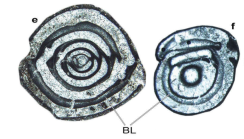Foraminifera taxon details
Idalina praecaenozoica Consorti, Schlagintweit & Rashidi, 2021 †
1376428 (urn:lsid:marinespecies.org:taxname:1376428)
accepted
Species
marine, brackish, fresh, terrestrial
fossil only
Consorti, L.; Schlagintweit, F.; Rashidi, K. (2021). A new Idalina (Milioloidea, benthic Foraminifera) and some associated fauna from the upper Maastrichtian Tarbur Formation of SW Iran. <em>Historical Biology 33 (6), 837–845.</em> , available online at https://doi.org/10.1080/08912963.2019.1663842 [details] Available for editors  [request]
[request]
Description Macrospheric specimen show a rounded prolo- cular chamber of about 125 μm diameter. The triloculine stage is followed by...
Description Macrospheric specimen show a rounded prolo- cular chamber of about 125 μm diameter. The triloculine stage is followed by at least four bilocular whorls. The max- imum equatorial diameter at the fourth bilocular whorl is about 1.5 mm. The basal layer arises from the bottom of the bilocular chambers in the third whorl. The maximum thickness of the basal layer is about 130 μm, whereas in some cases it appears very thin. The chamber height of the bilocular stage increases gradually from 120 μm in the first whorl up to 400 μm in the last whorl.
Proloculus of microspheric forms in centred sections is usually barely visible. These forms show an ovoid outline in the sub-axial view and are rounded to slightly axially com- pressed in sub-equatorial view. The quinquelocular stage is possibly reduced and difficult to observe. The maximum length observed in specimens displaying four whorls in subequatorial sections varies between 1.1–1.3 mm, whereas the axial length is around 2 mm. The triloculine stage is slightly elongated, the mean measurements of the streptospiral trilocular stage is around 220 μm in sub-equatorial direction and 420 μm in sub-axial view. The biloculine stage is the most developed. The trematophore is supported by, at least, three short pillars. The basal layer is not homogeneous: in some specimens it appears relatively thin. It is characterised by faint ribs that can considerably increase the thickness ranging from 30 μm to 160 μm. [details]
Proloculus of microspheric forms in centred sections is usually barely visible. These forms show an ovoid outline in the sub-axial view and are rounded to slightly axially com- pressed in sub-equatorial view. The quinquelocular stage is possibly reduced and difficult to observe. The maximum length observed in specimens displaying four whorls in subequatorial sections varies between 1.1–1.3 mm, whereas the axial length is around 2 mm. The triloculine stage is slightly elongated, the mean measurements of the streptospiral trilocular stage is around 220 μm in sub-equatorial direction and 420 μm in sub-axial view. The biloculine stage is the most developed. The trematophore is supported by, at least, three short pillars. The basal layer is not homogeneous: in some specimens it appears relatively thin. It is characterised by faint ribs that can considerably increase the thickness ranging from 30 μm to 160 μm. [details]
Hayward, B.W.; Le Coze, F.; Vachard, D.; Gross, O. (2024). World Foraminifera Database. Idalina praecaenozoica Consorti, Schlagintweit & Rashidi, 2021 †. Accessed at: https://www.marinespecies.org/foraminifera/aphia.php?p=taxdetails&id=1376428 on 2024-04-27
Date
action
by
original description
Consorti, L.; Schlagintweit, F.; Rashidi, K. (2021). A new Idalina (Milioloidea, benthic Foraminifera) and some associated fauna from the upper Maastrichtian Tarbur Formation of SW Iran. <em>Historical Biology 33 (6), 837–845.</em> , available online at https://doi.org/10.1080/08912963.2019.1663842 [details] Available for editors  [request]
[request]
From editor or global species database
Description Macrospheric specimen show a rounded prolo- cular chamber of about 125 μm diameter. The triloculine stage is followed by at least four bilocular whorls. The max- imum equatorial diameter at the fourth bilocular whorl is about 1.5 mm. The basal layer arises from the bottom of the bilocular chambers in the third whorl. The maximum thickness of the basal layer is about 130 μm, whereas in some cases it appears very thin. The chamber height of the bilocular stage increases gradually from 120 μm in the first whorl up to 400 μm in the last whorl.Proloculus of microspheric forms in centred sections is usually barely visible. These forms show an ovoid outline in the sub-axial view and are rounded to slightly axially com- pressed in sub-equatorial view. The quinquelocular stage is possibly reduced and difficult to observe. The maximum length observed in specimens displaying four whorls in subequatorial sections varies between 1.1–1.3 mm, whereas the axial length is around 2 mm. The triloculine stage is slightly elongated, the mean measurements of the streptospiral trilocular stage is around 220 μm in sub-equatorial direction and 420 μm in sub-axial view. The biloculine stage is the most developed. The trematophore is supported by, at least, three short pillars. The basal layer is not homogeneous: in some specimens it appears relatively thin. It is characterised by faint ribs that can considerably increase the thickness ranging from 30 μm to 160 μm. [details]
